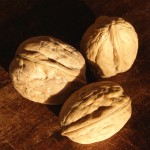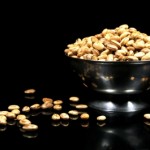 Look for walnuts featured on the lunch menu and snack cart this month. Walnuts are chock full of protein, fiber, antioxidants, magnesium and phosphorus. If you are thinking superfood, you are thinking right! And, out of all nuts, walnuts contain the highest amount of alpha-linolenic acid (ALA), an omega-3 essential amino acid. A diet rich in ALA has been found to reduce the risk of heart disease. While heart disease is normally associated with adults, more and more children are being diagnosed with high cholesterol and the early stages of heart disease. Everyone can benefit from one ounce of walnuts a day. Have you had your handful?
Look for walnuts featured on the lunch menu and snack cart this month. Walnuts are chock full of protein, fiber, antioxidants, magnesium and phosphorus. If you are thinking superfood, you are thinking right! And, out of all nuts, walnuts contain the highest amount of alpha-linolenic acid (ALA), an omega-3 essential amino acid. A diet rich in ALA has been found to reduce the risk of heart disease. While heart disease is normally associated with adults, more and more children are being diagnosed with high cholesterol and the early stages of heart disease. Everyone can benefit from one ounce of walnuts a day. Have you had your handful?
Dietary Guidelines
...now browsing by category
I heart walnuts
Tuesday, October 5th, 2010Posted in Dietary Guidelines, Newsletter Articles | No Responses »
The spectrum of food
Sunday, September 12th, 2010 As mentioned last week, foods can be classified into a range of nutritional value. On one end, you have the healthiest foods and moving towards the other end, there is a gradual decrease in healthiness until reaching the most unhealthy foods. The foods on the healthy end of the spectrum tend to be whole foods, i.e. as close as possible to the way nature made them. These foods are fruits, vegetables, whole grains, and lean proteins. As these foods are processed and “tweaked” more and more from their natural state, they move down the health spectrum towards the unhealthy range. As the foods are processed more and more, their nutritional value tends to decrease due to the added artificial colors, preservatives, trans fats, and excessive amounts of sugars and sodium. Keep this spectrum in mind when choosing foods.
As mentioned last week, foods can be classified into a range of nutritional value. On one end, you have the healthiest foods and moving towards the other end, there is a gradual decrease in healthiness until reaching the most unhealthy foods. The foods on the healthy end of the spectrum tend to be whole foods, i.e. as close as possible to the way nature made them. These foods are fruits, vegetables, whole grains, and lean proteins. As these foods are processed and “tweaked” more and more from their natural state, they move down the health spectrum towards the unhealthy range. As the foods are processed more and more, their nutritional value tends to decrease due to the added artificial colors, preservatives, trans fats, and excessive amounts of sugars and sodium. Keep this spectrum in mind when choosing foods.
Posted in Dietary Guidelines, Newsletter Articles | No Responses »
Hydrating via the pee test
Thursday, May 20th, 2010 Temperatures are rising and spring sports are in full swing. Now is a great time to remind kids about staying hydrated. The average child needs 48 ounces of water daily (six 8 oz cups.) Add to that an additional 8 ounces of water for each half hour of strenuous activity. Is your child drinking enough? A great way to teach children how to check their hydration status is by telling them about the pee test. Having near colorless and odorless urine and having to urinate frequently are signs of good hydration. Thus, your child can tell that its time to drink more if they don’t have to urinate often or have dark yellow colored or strong smelling urine.
Temperatures are rising and spring sports are in full swing. Now is a great time to remind kids about staying hydrated. The average child needs 48 ounces of water daily (six 8 oz cups.) Add to that an additional 8 ounces of water for each half hour of strenuous activity. Is your child drinking enough? A great way to teach children how to check their hydration status is by telling them about the pee test. Having near colorless and odorless urine and having to urinate frequently are signs of good hydration. Thus, your child can tell that its time to drink more if they don’t have to urinate often or have dark yellow colored or strong smelling urine.
Be sure to help you child choose their drinks wisely. Good old water is all that is need for day to day hydration. Water is also adequate for athletic activities less than 1 hour in length. There are a bevy of beverages available these days – fruit drinks, sports drinks, enhanced “waters” – but these for the most part are unnecessary and provide empty calories. Sports drinks and diluted 100% fruit juice can be useful for strenuous activities greater than an hour. When exercising continuously for this length of time, the sugar and electrolytes in these drinks provide additional fuel to muscles. After strenuous exercise, encourage you child to drink a glass of milk. The protein and carbohydrate in milk will help with recovery.
Posted in Dietary Guidelines, Newsletter Articles, Nutrition for Parents, Sports Nutrition | No Responses »
Vitamin D
Saturday, April 24th, 2010Vitamin D plays a crucial role in the body’s absorption of calcium for maintaining bone health. Without enough vitamin D, the bones will soften, leading to rickets in children or osteomalacia in adults. New research suggests that the vitamin may also play a role in immunity and protect against diabetes, high blood pressure, heart disease and certain cancers. Unfortunately, research is also finding that vitamin D deficiencies are estimated to occur in 30-50% of the population, numbers higher across all age groups than previously thought.
The body does produce vitamin D when exposed to sunlight. However, for those living in places with inadequate sunlight (a.k.a Vermont, especially when it is 37 degrees and snowy in the end of April), the body has trouble producing enough vitamin D. For these individuals, it is particularly important to get sufficient vitamin D from the diet. The primary source of vitamin D for Americans is milk. Other sources include whole eggs, fatty fish such as catfish, mackerel and salmon, and fortified foods such as yogurt, breakfast cereals, breads, margarine and oil spreads.
Due in part to the new findings regarding the function of vitamin D and prevalence of deficiencies, recommendations for daily intake are variable. Dosage for vitamin D is measured in International Units (IU) and the best bet appears to be a daily dosage of 400 IU per day for children, or the amount in 4 glasses of milk, and should not exceed 2,000 IU daily. Adults should have 400-800 IU daily without exceeding 10,000 IU.
Posted in Dietary Guidelines, Newsletter Articles | No Responses »
Pecans desire more than just pie
Wednesday, April 21st, 2010April is the month of mud for Vermonters but, across the United States, it is National Pecan month. Indeed, 80 percent of the world supply of pecans comes from our country’s southern states. Pecans are a nutritious food loaded with vitamin E, protein, magnesium and fiber. Like all nuts, the fat content does bump up the calories so it is important to watch your portion sizes. Luckily, because pecans are a tree nut, most of their fat is the unsaturated, healthy variety.
Nutty Granola
3 cups old-fashioned oats
½ cup chopped raw, unsalted walnuts
½ cup chopped unsalted almonds
½ cup unsalted pecans
½ cup maple syrup
½ tsp salt
¼ tsp ground cinnamon
½ cup raisins (optional)
Preheat oven to 300? F. Spray large baking sheet with cooking spray or cover with parchment paper. In a medium bowl, combine all ingredients. Spread the mixture onto baking sheet and bake until golden, stirring occasionally, about 30 minutes. Let cool completely. Store in refrigerator in airtight container.
Posted in Dietary Guidelines, Newsletter Articles | No Responses »
Sweet potato biscuits
Tuesday, April 6th, 2010Picture a biscuit in your mind – flaky, fluffy, buttery, and horribly unhealthy due to the high saturated fat content. The version below uses sweet potato in place of butter to produce a slightly sweeter tasting biscuit that is drastically lower in fat and higher in vitamin A. Using mashed fruits or vegetables, such as sweet potatoes, apples, pumpkins, bananas, or prunes, is a good way to tweak baked goods. Some experimentation is required but a good place to start is by replacing half of the fat and evaluating the result. Depending on the recipe, you may be able to completely swap out the fat with one of these fruits or vegetables and still have an acceptable final product.
Sweet Potato Biscuits
1 1/4 cups sweet potato, cooked and mashed
3 tbsp sugar
2 tbsp oil
1 1/2 cups flour
2 tsp baking powder
1/4 tsp salt
1/2 tsp cinnamon
Mix sweet potatoes, sugar, and oil. Mix flour, baking powder, salt, and cinnamon. Add to sweet potatoes. Mix well. Turn out onto floured surface. Knead lightly. Pat or roll dough into a one-half inch thickness. Cut into biscuits. Place each on greased baking sheet. Bake in 425 degree oven for 15 minutes.
Posted in Dietary Guidelines, Newsletter Articles | No Responses »
Dried Fruit
Tuesday, March 30th, 2010In another marketing gimmick, the food industry has taken dried fruit from its image as simply the prunes eaten by grandparents, and turned it into a hot health food with many exciting options. But, how does it really measure up?
Dried fruit has less vitamin C than fresh fruit. Good dental hygiene is a must, as well, because the sticky nature of dried fruit can lead to tooth decay. Dried fruit also has less water than fresh fruit which means that it has more calories per bite. Those calories are only further bumped by the frequent use of unhealthy additions – added sugar , granola clusters, chocolate, glazes, and a “yogurt” coating (which is really oil, sugar, and non-fat milk powders).
That being said, dried fruits do offer a good, convenient alternative to fresh fruit for meeting the recommended daily servings of fruit. Just be sure to keep these tips in mind when shopping. Fruit contains naturally occurring sugar so the food label can be misleading. When looking for sugar content, instead look at the ingredient list. Skip any with added sugar. Other than cranberries, additional sweetening shouldn’t be needed. Banana chips tend to be fried in coconut oil – another skip. Finally, don’t purchase any dried fruit based on claims such as their antioxidant content, ability to “cleanse and purify the heart”, or added vitamins. Most claims are unsubstantiated.
Posted in Dietary Guidelines, Newsletter Articles | No Responses »
Pumping up the iron
Wednesday, March 3rd, 2010 Is your child feeling sluggish and tired? Having trouble fighting colds? One possible explanation may be that your child is low in iron. In the body, iron aids with the transport of oxygen in the blood to the muscles and tissues. In the tissues, iron helps produce energy, support the immune system and aids in brain development. Thus, when the body doesn’t have enough iron stores, it can result in poor academic performance, fatigue, trouble maintaining body temperature, and decreased immune function.
Is your child feeling sluggish and tired? Having trouble fighting colds? One possible explanation may be that your child is low in iron. In the body, iron aids with the transport of oxygen in the blood to the muscles and tissues. In the tissues, iron helps produce energy, support the immune system and aids in brain development. Thus, when the body doesn’t have enough iron stores, it can result in poor academic performance, fatigue, trouble maintaining body temperature, and decreased immune function.
The recommended intake for children aged 4-8 is 10 mg/day and for children aged 9-13, the recommendation decreases to 8 mg/day. You can help your child meet these levels by offering plenty of foods high in iron such as lean beef, turkey and pork, enriched breads and cereals, and beans. Preparing food in an iron skillet can also transfer some iron from the skillet to the food being cooked. Also, vitamin C boosts the absorption of iron from food. Therefore, serving an iron-packed lean beef burger with a vitamin C-rich slice of tomato gets you a double punch of nutrition.
Posted in Dietary Guidelines, Newsletter Articles | No Responses »
Mooooo
Tuesday, February 9th, 2010 All cow milk has roughly the same amount of calcium and protein. The difference among types of cow milk is based upon the different amounts of fat in the milk. Whole milk is milk that has nothing removed. Its fat content is about 4% of its total content. Two percent milk has roughly half as much fat as whole milk. Similarly, 1% milk has half as much fat as 2% milk. Nonfat milk has all of the fat removed and is also called skim milk, based upon the way the cream is “skimmed” off the top of the milk during production.
All cow milk has roughly the same amount of calcium and protein. The difference among types of cow milk is based upon the different amounts of fat in the milk. Whole milk is milk that has nothing removed. Its fat content is about 4% of its total content. Two percent milk has roughly half as much fat as whole milk. Similarly, 1% milk has half as much fat as 2% milk. Nonfat milk has all of the fat removed and is also called skim milk, based upon the way the cream is “skimmed” off the top of the milk during production.
Children under the age of two need whole milk because the additional fat is needed for nerve and brain development. However, older children and adults do not need the additional fat and would benefit in general from fewer calories and fat. Thus it is recommended for the general population to gradually transition to 1% or nonfat milk after the age of two. While 2% milk may sound much healthier than whole milk, it still contains the same amount of fat as in about 2 slices of bacon. If your family hasn’t already made the transition, gradually begin working down towards 1% or nonfat milk. To ease the transition, you can mix two grades of milk together, such as whole and 2% milk, and slowly increase the proportion of the lesser fat milk until your family’s tastes have adapted.
Posted in Dietary Guidelines, Newsletter Articles | No Responses »
Getting a leg up with some legumes
Tuesday, January 12th, 2010 Legumes, or beans, black-eyed peas, and lentils, are a dietary source of protein. Similar to animal proteins such as meat, poultry and fish, these plant proteins also provide iron and zinc. In addition, because they come from plants, legumes are a great source of fiber, folate, and naturally cholesterol-free.
Legumes, or beans, black-eyed peas, and lentils, are a dietary source of protein. Similar to animal proteins such as meat, poultry and fish, these plant proteins also provide iron and zinc. In addition, because they come from plants, legumes are a great source of fiber, folate, and naturally cholesterol-free.
White Bean Burgers
1 can (15-16 oz) great northern beans, drained
1 can (4 oz) chopped green chiles, undrained
2 medium green onions, chopped
1 cup plain dry bread crumbs
1 egg, beaten
¼ cup yellow cornmeal
2 tbsp vegetable oil
Slices of cheese (such as Monterey Jack and Provolone)
Mash beans in a bowl. Mix in chiles, onions, breadcrumbs and eggs. Shape into 4-5 patties. Coat each patty with cornmeal.
Heat oil in large skillet over medium heat. Cook patties in oil around 8-10 minutes, turning at least once until crisp on both sides.
Top with cheese slices and cover until cheese is melted.
Posted in Dietary Guidelines, Newsletter Articles | No Responses »
